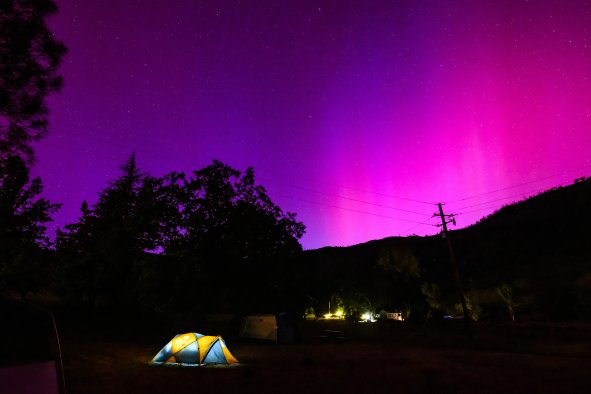Seven different stars in our galaxy may show signs of being contained within Dyson spheres, megastructures that could be constructed by advanced civilizations to harness radiation energy from stars, new research has found.
These stars are all low-mass M dwarf stars—much smaller than our sun—and are all within 1,000 light-years of our planet, according to a new paper in the journal Monthly Notices of the Royal Astronomical Society.
The light from these stars showed a strange spike in infrared wavelengths known as infrared excess emissions (IEEs), which researchers associate with the potential existence of such alien mega-structures.
"After analyzing the optical/NIR/MIR photometry of [around 5 million] sources, we found seven apparent M dwarfs exhibiting an infrared excess of unclear nature that is compatible with our [Dyson sphere] model," the researchers wrote in the paper.
A Dyson sphere is a hypothetical megastructure proposed by physicist Freeman Dyson in 1960, which involves surrounding a star with a vast array of solar energy collectors or habitats to capture a significant portion of the star's energy output. Such a structure could provide energy far beyond what any civilization on Earth currently consumes.
This hypothetical structure could come in different forms: a Dyson swarm of small individual solar collectors orbiting the star, or a Dyson shell, comprising a solid shell totally encasing the star. Of the two, the Dyson swarm is considered the most feasible because of the engineering challenges of constructing a solid shell.
Researchers think that if Dyson spheres did exist, we should be able to spot them, as heat from the star would cause the solar collectors of the sphere to reach immense temperatures, releasing infrared radiation that we could observe.
"Starlight harvesting could, in principle, result in different observational signatures that may be detected using existing telescopes," the researchers wrote in the paper. "These signatures include optical dimming of the host star due to direct obscuration, and waste-heat emission from the absorbing structure.
"Consequently, searching for anomalous infrared beacons in the sky has become an alternative to traditional communication-based searches for technologically advanced civilizations. One of the advantages of searches based on 'Dysonian' signatures is that it does not rely on the willingness of other civilizations to contact us."
Therefore, researchers look for these IEEs in the spectra of stars as a sign that a Dyson sphere could be present.
According to the paper, the researchers used a computer program to analyze the light from over 5 million stars across our galaxy. They found seven stars with IEE signatures that make them prime candidates to have Dyson spheres.
Another non-peer-reviewed paper from March also analyzed 5 million stars in our galaxy and found 53 potential IEE candidates. However, it's unclear if these two studies used the same dataset of stars.
Of course, these IEE signatures could be caused by other phenomena, including disks of debris around the stars, or nebulas. Nevertheless, this new evidence will spur further research into signs of intelligent life hidden out in the cosmos.
Do you have a tip on a science story that Newsweek should be covering? Do you have a question about Dyson spheres? Let us know via science@newsweek.com.
Disclaimer: The copyright of this article belongs to the original author. Reposting this article is solely for the purpose of information dissemination and does not constitute any investment advice. If there is any infringement, please contact us immediately. We will make corrections or deletions as necessary. Thank you.



